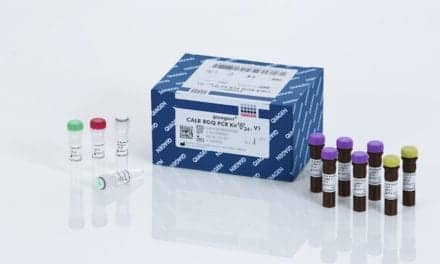Results from a first-of-its-kind study of a multicancer blood test involving more than 9,900 women with no evidence or history of cancer showed that the liquid biopsy test safely detected 26 undiagnosed cancers, enabling potentially curative treatment.1
Overall, 26 cancers were detected by the blood test while an additional 24 cancers were detected by standard screening such as mammography or colonoscopy. Taken together, cancers detected by either blood testing or standard screening accounted for more than half of the 96 cancers detected during the study period. Cancers detected by the blood test were most often localized by diagnostic positron emission tomography-computed tomography (PET-CT). Twelve of the cancers detected by the blood test were able to be surgically removed.
The multicancer blood test was developed by researchers at the Johns Hopkins Kimmel Cancer Center, and detects the presence of cancer gene mutations in circulating DNA and blood levels of specific cancer proteins. The researchers’ study, called detecting cancers earlier through elective mutation-based blood collection and testing (Detect-A), represents the first time any liquid biopsy blood test has been used clinically to screen for cancer in a population without previously detected cancer for the purpose of diagnosis and intervention—specifically, treatment with the intent to cure cancer.
“This study suggests that a multicancer blood test can be complementary and additive to standard-of-care screening and may be a good strategy for increasing early detection of cancer,” says Anne Marie Lennon, MBBCh, PhD, professor of medicine at Johns Hopkins University and lead author of the published report.
“The Detect-A study incorporated PET-CT imaging to provide independent confirmation of the existence of a cancer and to precisely localize its site,” says Nickolas Papadopoulos, PhD, professor of oncology and pathology at Johns Hopkins University and senior author of the study. “For example, we could detect a lung cancer, tell in which lobe of which lung the cancer was located, the size of the cancer, and if there were metastatic lesions present. Blood tests alone are not able to provide this type of precise information.”
In the Detect-A study, the blood test followed by PET-CT imaging was 99.6% specific for cancer. The researchers also confirmed that the genetic mutations picked up by the blood test that led to a positive test were present in the cancer 100% of the time.
“Our primary goal was to demonstrate reliability and safety—to show the blood test could lead to the diagnosis of cancers and get patients to treatment aimed at curing them,” says Kenneth Kinzler, PhD, professor of oncology at Johns Hopkins University. “A secondary goal was to show that blood testing could be integrated with conventional screening methods for detecting breast, colon, and lung tumors.”
Papadopoulos says it was encouraging that the Detect-A study found combining standard-of-care screening with the blood test augmented the benefit of standard-of-care screening for these three cancer types, improving sensitivity from 47% to 71%. Blood testing also allowed the detection of seven other cancer types (appendix, kidney, lymphoma, ovary, thyroid, uterine, and cancers arising from an unknown primary site) that cannot be screened now, with a sensitivity of 31%. “This underscores the value of blood-based multicancer screening as both complementary and additive to standard-of-care screening,” he says.
Only women were chosen for the Detect-A study because ovarian cancer—one of the cancers the test detects—occurs only in women, and the investigators wanted to have consistent comparisons.
Of the 10,006 female patients initially enrolled between September 2017 and May 2019, 9,911 completed the study. Of the 95 people excluded from the study, 73 voluntarily withdrew, 12 were found to have a history of cancer, and 10 did not complete the necessary clinical workup.
Because study participants were all members of a managed healthcare system, all had access to standard-of-care cancer screening guidance, including recommendations for mammography to detect breast cancer and colonoscopy to detect colon cancer.
Cancers initially detected by the blood test included cancers of 10 different types: appendix (1), breast (1), colorectal (2), kidney (1), lung (9), lymphomas (2), ovary (6), thyroid (1), uterine (2), and unknown primary site (1).
Importantly, 17 cancers (65%) first detected by the blood test were diagnosed at an early stage, when the cancer was still localized or regional to the area in which it originated. Twelve surgeries were performed with intent to cure. Of the 26 patients first detected by blood testing, 12 remain in remission and eight remain in treatment or have stable disease approximately 9 months past diagnosis.
The investigators plan to continue following all 9,911 participants, including those with positive and negative test results, for 5 years. It is likely that other cancers that were too small to be detected by imaging or were not detected by the blood test will arise in these individuals.
The investigators say additional studies reflecting an optimized version of the blood test are in planning. “We believe that more than two-thirds of cancers that occur in the United States can eventually be screen-detected, either by blood testing or standard screening, before they cause symptoms of disease,” says Bert Vogelstein, MD, a professor of oncology at Johns Hopkins University and a Howard Hughes Medical Institute investigator. “Such earlier detection has the capacity to substantially reduce suffering and death from many cancer types.”
The Detect-A test remains in research and is not currently available to the general public. Read more from Johns Hopkins Medicine.
Reference
1. Lennon AM, Buchanan AH, Kinde I, et al. Feasibility of blood testing combined with PET-CT to screen for cancer and guide intervention. Science. Epub April 28, 2020; doi: 10.1126/science.abb9601.
Featured image: Cancers initially detected by the Detect-A blood test included 10 different types. Illustration by Elizabeth Coo courtesy Johns Hopkins University.





